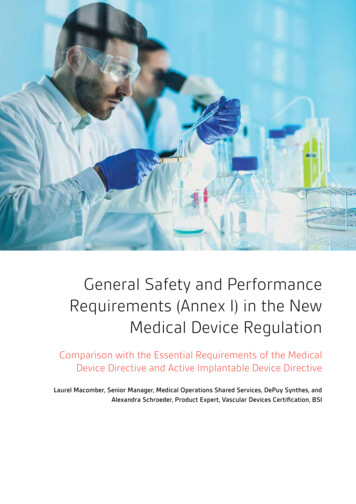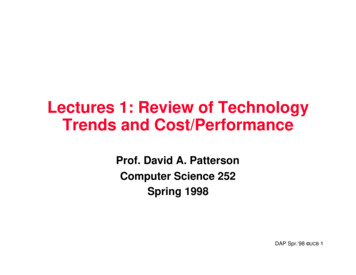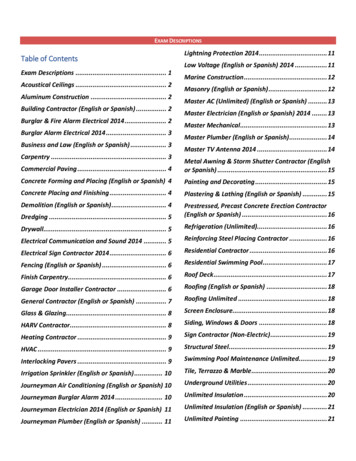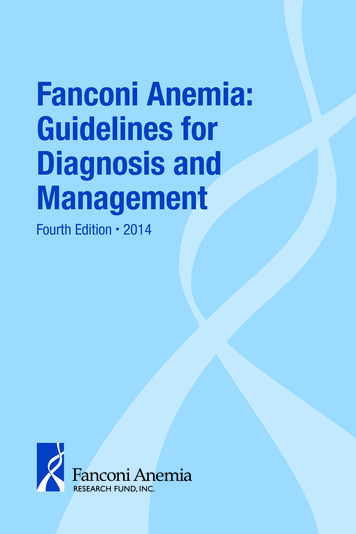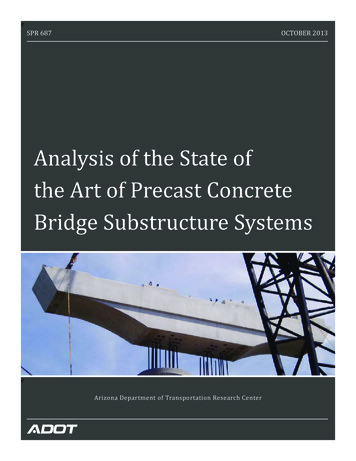
Transcription
eSPR 687OCTOBER 2013Analysis of the State ofthe Art of Precast ConcreteBridge Substructure SystemseArizona Department of Transportation Research Center
Analysis of the State ofthe Art of Precast ConcreteBridge Substructure SystemsFinal Report 687October 2013Prepared by:Joshua T. Hewes, Ph.D., P.E.AZTrans: The Arizona Laboratory for Applied Transportation ResearchNorthern Arizona UniversityDepartment of Civil Engineering, Construction Management, and Environmental EngineeringFlagstaff, AZ 86011‐6050Prepared for:Arizona Department of Transportation206 South 17th AvenuePhoenix, Arizona 85007In cooperation withU.S. Department of TransportationFederal Highway Administration
This report was funded in part through grants from the Federal Highway Administration, U.S.Department of Transportation. The contents of this report reflect the views of the authors, whoare responsible for the facts and the accuracy of the data, and for the use or adaptation ofpreviously published material, presented herein. The contents do not necessarily reflect theofficial views or policies of the Arizona Department of Transportation or the Federal HighwayAdministration, U.S. Department of Transportation. This report does not constitute a standard,specification, or regulation. Trade or manufacturers’ names that may appear herein are citedonly because they are considered essential to the objectives of the report. The U.S. governmentand the State of Arizona do not endorse products or manufacturers.
Technical Report Documentation Page1. Report No.2. Government Accession No.3. Recipient's Catalog No.FHWA‐AZ‐13‐6874. Title and SubtitleAnalysis of the State of the Art of Precast ConcreteBridge Substructure Systems5. Report DateOctober 20136. Performing Organization Code7. AuthorJoshua T. Hewes, Ph.D., P.E.8. Performing OrganizationReport No.9. Performing Organization Name and AddressAZTrans: The Arizona Laboratory for Applied Transportation Research10. Work Unit No.Northern Arizona UniversityCollege of Engineering and Natural SciencesCivil and Environmental Engineering DepartmentP.O. Box 15600Flagstaff, AZ 86011‐560011. Contract or Grant No.SPR 000‐1 (177) 68712. Sponsoring Agency Name and Address13. Type of Report & PeriodCoveredARIZONA DEPARTMENT OF TRANSPORTATION206 S. 17th Avenue,Phoenix, AZ 85007.FINAL REPORT14. Sponsoring Agency Code15. Supplementary NotesPrepared in cooperation with the U.S. Department of Transportation, Federal Highway Administration16. AbstractPrecasting of bridge substructure components holds potential for accelerating the construction of bridges, reducingimpacts to the traveling public on routes adjacent to construction sites, improving bridge durability and hence servicelife, and reducing the environmental impacts that are associated with cast‐in‐place construction operations. Use ofprecast concrete substructures has been limited in the United States; only recently have state departments oftransportation (DOTs) developed and implemented technologies that speed construction through the use ofprefabricated columns, cap beams, and footings. In this research, the author gathered relevant information on the useof precast substructures by state DOTs, and analyzed existing technologies for appropriateness of use on typicalbridges within Arizona. Drawing from the collected literature, the author makes recommendations for implementingprecast substructures.17. Key Words18. Distribution StatementPrefabricated, Substructure, Precast Concrete, ABCDocument is available to theU.S. Public through the NationalTechnical Information Service,Springfield, Virginia, 2216119. SecurityClassification21. No. ofPages20. Security ClassificationUnclassifiedUnclassified12422. Price23.Registrant'sSealNotApplicable
SI* (MODERN METRIC) CONVERSION FACTORSAPPROXIMATE CONVERSIONS TO SI UNITSSymbolWhen You KnowMultiply squaresquaresquareacressquarefl ozgal3ft3ydfluid ouncesgallonscubic feetcubic yardsozlbTouncespoundsshort tons (2000 /inpoundforcepoundforce per square inch25.40.3050.9141.61To quare millimeterssquare meterssquare metershectaressquare kilometersmm2m2mha2kmmillilitersliterscubic meterscubic meters3shown in mmLL3m3mgramskilogramsmegagrams (or "metric ton")gkgMg (or s2VOLUME29.573.7850.0280.765NOTE: volumes greater than 1000 L shall beMASS28.350.4540.907TEMPERATURE (exact degrees)F5 (F-32)/9or N10.763.426FORCE and PRESSURE or STRESS4.456.89newtonskilopascalsNkPaAPPROXIMATE CONVERSIONS FROM SI UNITSSymbolWhen You y ByLENGTH0.0393.281.090.621To a2kmsquare millimeterssquare meterssquare metershectaressquare OLUMEmLL3m3mmillilitersliterscubic meterscubic meters0.0340.26435.3141.307gkgMg (or "t")gramskilogramsmegagrams (or "metric ton")oCelsiusfluid ouncesgallonscubic feetcubic yardsfl ozgal3ft3ydouncespoundsshort tons (2000 lb)ozlbTMASS0.0352.2021.103TEMPERATURE (exact degrees)C1.8C 9290.2919FORCE and PRESSURE or STRESS0.2250.145poundforcepoundforce per square inchlbf2lbf/in*SI is the symbol for the International System of Units. Appropriate rounding should be made to comply with Section 4 of ASTM E380.(Revised March 2003)
TABLE OF CONTENTSEXECUTIVE SUMMARY .1CHAPTER 1. INTRODUCTION .3BACKGROUND . 3SCOPE OF RESEARCH . 4ORGANIZATION OF THE REPORT . 5CHAPTER 2. REVIEW OF CURRENT PRACTICE AND LITERATURE .7FEDERAL HIGHWAY ADMINISTRATION . 7Prefabricated Bridge Elements and Systems . 7Accelerated Construction Technology Transfer (ACTT) . 10NATIONAL COOPERATIVE HIGHWAY RESEARCH PROGRAM . 11NCHRP Synthesis 324 (TRB 2003) . 11PCI “GUIDELINES FOR ABC”. 12STATE DOT PRACTICE AND RESEARCH . 13Alabama . 13California . 13Florida. 16Michigan . 17Oregon . 18Texas. 18Utah . 19Washington . 20REVIEW OF PRECAST SUBSTRUCTURE PROJECTS. 24California . 24Florida. 27Georgia . 28Maine . 30Michigan . 32New Hampshire . 33New York . 33Texas. 35Utah . 44Washington . 45CHAPTER 3. PRECAST BENT CAPS . 47TEXAS PRECAST BENT CAP SYSTEM. 47Connection Types . 48Design Recommendations . 51Implementation of Texas Precast Bent Cap Research . 52UTAH PRECAST BENT CAP SYSTEM . 54Overview . 54UDOT Precast Cap Beam Details . 54v
Grout‐Filled Splice Sleeve Couplers. 59ALABAMA PRECAST BENT CAP SYSTEM . 60WASHINGTON DOT PRECAST BENT CAP SYSTEM . 62CHAPTER 4. PRECAST COLUMNS . 65PRECAST CONCRETE COLUMN SYSTEMS . 65Precast Concrete Shells. 65Conventionally Reinforced Precast Columns . 66Hybrid Precast Columns. 67Full‐Height and Segmental Columns . 69Cross‐Section Geometry . 69CONNECTIONS BETWEEN COLUMN SEGMENTS . 75Match‐Cast and Grouted Segment Joints. 75Longitudinal Reinforcement Connection . 76CONNECTIONS BETWEEN COLUMNS AND FOUNDATIONS. 77Grouted Splice Coupler Connection . 77Column with Support Leg Connection . 79Post‐Tensioned Connection . 81CHAPTER 5. PRECAST FOOTINGS . 83ISSUES WITH PRECAST CONCRETE SPREAD FOOTINGS . 83PRECAST FOOTINGS ON DEEP FOUNDATIONS . 87DESIGN OF PRECAST FOOTINGS . 89CHAPTER 6. RECOMMENDATIONS FOR IMPLEMENTATION . 91ABC IMPLEMENTATION . 91ABC Advisory Committee . 92Survey of ABC Practice. 92ABC Decision Making. 93Industry Involvement . 93Technical Standards Development . 94Technical Research . 94Phased Implementation and Continuous Improvement Process. 94PRECAST SUBSTRUCTURE IMPLEMENTATION . 94Bent Cap Beams . 95Columns and Pier Walls . 96Footings . 96SUMMARY . 96REFERENCES. 99APPENDIX A . 105APPENDIX B . 113APPENDIX C . 115vi
LIST OF FIGURESFigure 1. Column‐Cap Beam Subassemblies Tested. (Pang et al. 2008.) . 23Figure 2. Precast Bent Cap Being Lowered into Position on San Mateo Bridge. (Chung et al. 2009.). 25Figure 3. Integral Bent Connection Region on San Mateo Bridge. (Chung et al. 2009.) . 26Figure 4. Precast Concrete Abutment at Marble Wash Bridge, I‐40. (Blanchard et al. 2009.) . 26Figure 5. Precast Column Segment on Edison Bridge. (FHWA 2009.) . 28Figure 6. Erection of Precast Bents on Edison Bridge. (Ericson 2005.) . 28Figure 7. Precast Concrete Bents on Kia Boulevard Bridge. (FHWA 2010b.) . 29Figure 8. Erection of Precast Concrete Columns on Kia Boulevard Bridge. (FHWA 2010b.) . 30Figure 9. Completed Intermediate Bents on Kia Boulevard Bridge. (FHWA 2010b.) . 30Figure 10. Construction of the All‐Prefabricated David Narrows Bridge. (PCINE 2006.) . 31Figure 11. Precast Pile Cap Being Lowered into Position on Parkview Avenue Bridge. (Photo Courtesyof MDOT.) . 32Figure 12. Precast Columns in Casting Yard on Parkview Avenue Bridge. (Photo Courtesy of MDOT) . 32Figure 13. Precast Bent Cap Being Lowered into Position on Parkview Avenue Bridge. (Cooper 2009,courtesy of MDOT.) . 33Figure 14. Precast Concrete Piers on Cross Westchester Expressway Viaduct. (FHWA 2009.) . 34Figure 15. Pier Details on the Cross Westchester Expressway Viaduct. (FHWA 2009.) . 35Figure 16. Precast Cap on Red Fish Bay and Morris and Cummings Cut Bridge. (Wolf 2005.) . 36Figure 17. Precast Cap on Red Fish Bay and Morris and Cummings Cut Bridge. (Wolf 2005.) . 36Figure 18. Assembly of Precast Segmental Columns on Louetta Road Overpass. (CABA, ND Slide 24.) . 37Figure 19. Completed Precast Columns and Cap, Louetta Road Overpass. (CABA, ND, Slide 6.) . 37Figure 20. Precast Bent Cap Lowered into Position on Ramp E‐3 Structure. (Marin 2008.) . 38Figure 21. Precast Superstructure Beams Resting on Precast Bent Cap on Ramp E‐3. (Marin 2008.) . 38Figure 22. Precast Cap Placement on Pierce Elevated Freeway, Houston. (Wolf 2005.) . 39Figure 23. Placement of Precast Bent Cap on Lake Ray Hubbard Bridge. (FHWA 2009.) . 40Figure 24. Precast Cap Beam Being Lowered into Position on Lake Belton Bridge. (FHWA 2009.) . 40Figure 25. Completed Lake Belton Bridge. (Marin 2008.). 41Figure 26. Lifting Precast Column Shell into Place, SB 340 over IH‐35. (Wolf 2005.) . 42Figure 27. Precast Column Shells Before Core Filling on SB 340 over IH‐35. (Wolf 2005.) . 42Figure 28. Base of Precast Column Shell After Core Concrete Filling. (Wolf 2005.) . 43Figure 29. Completed SB Bridge 340 over IH‐35. (Marin 2008.) . 43Figure 30. Installation of Precast Abutment, Cottonwood Creek Bridge. (Marin 2008.) . 44Figure 31. Completed Cottonwood Creek Bridge. (Marin 2008.) . 44Figure 32. Riverdale Road Bridge in Utah. (Burns 2008.). 45Figure 33. Template for Aligning Column Bars and Bent Cap Connection Ducts. (Pang et al. 2008.) . 46Figure 34. Precast Bent Cap in Place on SR 520 / SR 202 Interchange Flyover Ramp.(Pang et al. 2008.) . 46Figure 35. Double Line Grout Pocket Connection. (Matsumoto et al. 2001). . 49Figure 36. A Three‐Row/Two Connections Per Row Line Grouted Vertical Duct Connection.(Matsumoto et al. 2001.) . 50vii
Figure 37. Grouted Splice Sleeve Connection Proposed by Matsumoto et al. (2001). . 51Figure 38. UDOT Precast Cap Beam Connection, Elevation View. (UDOT 2010d.) . 55Figure 39. UDOT Precast Cap Beam Connection Plan View. (UDOT 2010d.) . 55Figure 40. UDOT Precast Cap Beam Cross‐Section View. (UDOT 2010d.) . 56Figure 41. UDOT Precast Cap Beam Connection to Column. (UDOT 2010d.) . 56Figure 42. UDOT Precast Concrete Single‐Column Bent. (UDOT 2010d.) . 57Figure 43. UDOT Precast Concrete Double‐Column Bent. (UDOT 2010d.) . 58Figure 44. UDOT Precast Concrete Components Tolerances. (UDOT 2010e.). 59Figure 45. Precast Bent Cap for Prefabricated Alabama Bridge. (Fouad et al. 2006.) . 61Figure 46. Large‐Diameter Bar Column‐to‐Cap Beam Connection. (Pang et al. 2008.) . 62Figure 47. Details of the Specimens Tested by Pang et al. (Pang et al. 2008.) . 63Figure 48. Precast Bridge Bent Proposed by Hieber et al. (Hieber et al. 2005a.) . 66Figure 49. Hybrid Precast Bridge Bent Proposed by Hieber et al. (Hieber et al. 2005a.) . 68Figure 50. UDOT Precast Concrete Column Standard Sections. (UDOT 2010d.) . 70Figure 51. Precast Column Developed for Standard Alabama Bridges. (Fouad et al. 2006.) . 71Figure 52. Precast Column Details for Prefabricated Alabama Bridge. (Fouad et al. 2006.) . 72Figure 53. Precast Column Details for Prefabricated Alabama Bridge. (Fouad et al. 2006.) . 73Figure 54. I‐Shaped Column Cross‐Section. . 74Figure 55. UT – Austin Precast Segmental Column Cross‐Sections. (Billington et al. 1998.) . 74Figure 56. Column Segment‐to‐Segment Connection via Grouted Splice Sleeve Couplers.(UDOT 2010d.) . 77Figure 57. Column/Footing Grout Splice Coupler Connection. (FHWA 2009.) . 78Figure 58. Detail of Grout Splice Coupler Connection. (FHWA 2009.). 78Figure 59. Precast Column Support Leg Detail for Mild Steel Rebar. (Hieber et al. 2005a.) . 79Figure 60. Precast Column Support Leg for Post‐Tensioned Rebar. (Hieber et al. 2005a.) . 80Figure 61. Precast Column Support Leg Connection to Drilled Shaft. (Hieber et al. 2005a.) . 81Figure 62. Precast Column with Post‐Tensioned Connection to Footing. (FHWA 2009.) . 82Figure 63. UDOT Precast Spread Footing. (UDOT 2010d.) . 84Figure 64. Precast Footing Leveling Mechanism Detail. (FHWA 2009.) . 85Figure 65. Precast Concrete Footing Being Lowered into Position on Native Subgrade. Mill StreetBridge over Lamprey River, New Hampshire. (FHWA 2009.) . 86Figure 66. UDOT Partial Precast Spread Footing. (UDOT 2010d.) . 87Figure 67. UDOT Precast Footing on Drilled Shaft or Pipe Piles. (UDOT 2010d.) . 88Figure 68. UDOT Precast Footing on Steel H‐Pile. (UDOT 2010d.) . 88Figure 69. PCI Northeast Precast Footing on Piles with Uplift. (PCINE 2006.) . 89Figure 70. PCI Northeast Precast Footing on Piles without Uplift. (PCINE 2006.) . 89Figure 71. UDOT Approach to Speeding Delivery of Bridge Projects in Utah. (UDOT 2010b.) . 92LIST OF TABLESTable 1. Advantages and Disadvantages of Connection Types. (Matsumoto et al. 2001.) . 53viii
SIGNIFICANT TERMS, ACRONYMS, AND ABBREVIATIONSAASHTOAmerican Association of State Highway and Transportation OfficialsABCAccelerated bridge constructionACIAmerican Concrete InstituteACTTAccelerated Construction Technology Transfer programADOTArizona Department of TransportationAlDOTAlabama Department of TransportationAZTransThe Arizona Laboratory of Transportation, which is the research unit at Northern ArizonaUniversity, Department of Civil and Environmental Engineering, that conducted this studyCaltransCalifornia Department of TransportationCIPCast‐in‐placedbDiameter of longitudinal reinforcing barDDBDDirect displacement‐based design methodDOTDepartment of TransportationELFDEquivalent lateral force design methodFHWAFederal Highway AdministrationGDOTGeorgia Department of TransportationI, IHInterstate, interstate highwayITSIntelligent transportation systemsMDOTMichigan Department of TransportationNCHRPNational Highway Cooperative Research ProgramNYSDOTNew York State Department of TransportationODOTOregon Department of Transportationix
PBESPrefabricated bridge elements and systemsPCINEPrecast/Prestressed Concrete Institute NortheastPTPost‐tensioning; post‐tensionedRCReinforced concreteSCOBAASHTO Subcommittee on Bridges and StructuresSHState highwaySPERSumitomo precast form for resisting earthquakes and for rapid constructionSPMTSelf‐propelled modular transporterSPUISingle‐point urban interchangeTACTechnical Advisory Committee: a group of stakeholders and advisors for the research projectTIGTechnology Implementation GroupTRBTransportation Research Board of the National AcademiesTxDOTTexas Department of TransportationUABUniversity of Alabama at BirminghamUDOTUtah Department of TransportationWSDOTWashington State Department of Transportationx
EXECUTIVE SUMMARYThe impacts of transportation construction activities on the traveling public are increasing significantlyas more bridges approach the ends of their useful service lives and require either replacement orrehabilitation. These impacts consist primarily of traffic congestion and the user delays caused by thatcongestion. Worker and traveler safety is also a concern. To mitigate these deleterious consequences ofconstruction activity, federal and state transportation agencies have focused on decreasing the timerequired for construction of bridges—i.e., accelerating bridge construction (ABC). In 2001, the AmericanAssociation of State Highway and Transportation Officials (AASHTO) Technology Implementation Group(TIG) identified prefabricated bridge construction as a technology that should be advanced andimplemented as quickly as possible (AASHTO 2002).Using prefabricated bridge systems and components can also provide other important benefits besidesrapid construction, including: Improved safety on the jobsite and for the traveling public.Ease of construction at sites with difficult access.Minimized environmental impacts of construction.Improved quality control.Ease of use of high‐performance concretes.Enhanced durability and hence lengthened life cycle.Bridge designs incorporating prefabricated superstructure elements are not new or innovative, asprecast concrete beams or girders have been around since roughly the 1950s. However, until the last 25years, incorporating precast concrete bridge substructure components into design has been verylimited. Some of the main reasons for this limited use include: Lack of design and detailing guidelines.Concerns regarding connection performance.Lack of construction specifications.Increased cost compared to cast‐in‐place (CIP) concrete construction.This research focused on the collection of information related to the design and construction of precastconcrete bridge substructures, with sources including state and federal transportation agency websitesand published literature; conference and workshop proceedings and presentations; professionalassociations and societies; and other published literature sources, such as technical journals. Thisproject reviewed this literature to determine the current state of practice with respect to the use ofprecast substructures on bridges in the United St
College of Engineering and Natural Sciences Civil and Environmental Engineering Department P.O. Box 15600 Flagstaff, AZ 86011‐5600 10. Work Unit No. 11. Contract or Grant No. SPR 000‐1 (177) 687 12. Sponsoring Agency Name and Address ARIZONA DEPARTMENT OF TRANSPORTATION 206 S. 17th Avenue,
